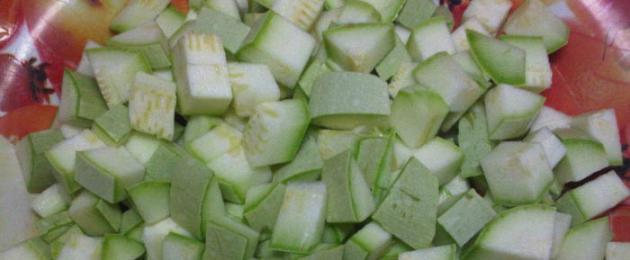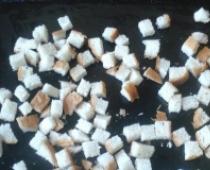Zirvak for the future
An ancient peculiar way of long-term storage of products, in this case, the preparation of pilaf, which arose long before the advent of refrigerators. This method has long been forgotten by everyone, but only one person, the poet, our contemporary A. Charkhi, has been preserved in the memory.
Zirvak is prepared for the future during the cool periods of the year, from November to April. The recipe is for one serving: 200 gr. lamb (pulp), 70 gr. lard, 200 gr. carrots, 100 gr. onions, spices (cumin. barberry, ground coriander, red pepper) - one pinch each, salt - to taste.
Cut the meat into slices, onion into rings. Mix both products, sprinkle with spices and salt and put in a cool place for a day for pickling.
The next day, heat up the cauldron, melt the mutton fat cut into cubes, remove the greaves and continue overheating for another half an hour. Cool slightly, add marinated meat with onions and fry until half cooked. Cut the carrots into cubes and fry together with the meat until fully cooked. Remove the cauldron from the fire, cool the zirvak to room temperature. Then transfer to a clean pottery pouring jug or enamel pot with a tight-fitting lid and place in a cool place.
Zirvak is stored for the future for two months, and even longer in the refrigerator. Such long-term storage is ensured by a large amount of fat, which solidifies, forming a dense hermetic layer on top of the meat with carrots. Zirvak prepared in this way in large quantities can be used as needed and depending on the number of diners.
To do this, put the necessary portion of zirvak into a heated cauldron, pour water at the level of the contents of the cauldron, let it boil and add the washed rice. Cook pilaf in Fergana style.
Zirvak saves the hostess time for the future and 10-15 portions of pilaf can be cooked in 30-35 minutes.
Canning pilaf was practiced in the 30s at the Yangiyul canning factory. The production of canned food with excellent taste was discontinued in 1941, this is understandable, but for unknown reasons it has not been resumed to this day. Great demand and the need to facilitate the work of housewives dictate the need to restore the recipe and technology for the production of such canned food.
For one serving: 200 gr. rice, 150 gr. fresh lamb (pulp), 80 gr. fat tail fat, 200 gr. carrots, 50 gr. onions, spices (cumin, barberry, red or black ground pepper, you can and peas - 10 pcs). salt - to taste.
Do not cover the finished pilaf, but immediately transfer it to glass jars. Dishes should be thoroughly washed with warm water, steam sterilized and dried.
Cover jars with pilaf with a metal lid (the lid must also be sterilized). Then pasteurize like other canned food home cooking. To do this, put a wooden grate on the bottom of an enameled bucket, pan or stainless steel barrel, pour water and let it heat up to a temperature corresponding to the temperature of the pilaf cans. Carefully lower the jars into the pasteurization vessel so that the water level reaches the bend of the jars (pilaf also fits up to the bend of the jars), let it boil. Pasteurization time for half-liter jars is 5-6 minutes after boiling, for liter jars - 10-12, for two-liter jars - 15-20 minutes. Then carefully remove from heat so that the lid does not move and air does not get inside the dishes, tighten. Leave closed jars upside down for 5-6 hours to cool, then put in a permanent storage place: basement, closet on the balcony, where it is dark and the air temperature does not exceed 15-25 °. Every two weeks, jars with pilaf are recommended to be viewed. If the contents begin to become moldy, and an unpleasant odor appears when the cans are opened, the pilaf is not suitable for consumption. To avoid this, from the beginning of cold processing of products to cooking pilaf and pasteurization, it is necessary to strictly observe all the rules of sanitation and hygiene.
Cooking vegetable pilaf with zucchini:
The main ingredients of our preparation will be vegetables, so they must first be sorted out well, the spoiled ones removed and washed well. We will cook pilaf with zucchini for the winter, so take care of the jars and lids in advance. We clean the jars, sterilize, dry. We repeat the same procedure with lids.
We cut the prepared vegetables into small cubes.

Onions can be cut into rings or half rings - if desired.

Carrots are best grated on a coarse grater, but you can also cut them into small cubes.

We shift all the vegetables except the onion into a convenient bowl, mix well, add a little vegetable oil, salt and spices.

Pour vegetable oil into a separate bowl and heat it well. Fry the onion until slightly golden and only then add the rest of the vegetables.
If you are using fresh tomatoes, remove the skin from them. To do this, they will need to be dipped in boiling water for a few seconds, then immediately cooled under cold water - the skin will easily come off. While the vegetables are roasting, prepare the rice.

Wash rice well to remove excess starch. Then soak in a small amount of water - cook it until tender, but do not digest. You can take steamed rice, then it will be enough just to rinse it.

Add rice and some water - it is necessary that all vegetables and rice are covered with liquid. Can be poured over vegetables tomato juice- dilute the tomato paste in water, but then consider the number of tomatoes so that the pilaf is not too sour.
You can add mushrooms to rice - then they must first be boiled in water with onions. Pilaf needs to be stewed for about 20 minutes so that it is completely ready.

After that, add vinegar, boil for a few more minutes and immediately lay out in jars.

We sterilize the jars for 10-20 minutes, depending on the size of the jars, roll them up and wrap them in a warm cloth. When the vegetable pilaf has cooled, you can put it in storage.
Preparation of vegetable pilaf with eggplant:
There are a lot of recipes for cooking homemade preparations from vegetables. However, not all of them are as popular as vegetable pilaf for the winter. In we prepared a preparation of zucchini, this time I offer you a recipe for vegetable pilaf with eggplant.
To do this, we also take fresh vegetables, the only difference is that we will not use tomatoes, but take 100 grams at once tomato paste. Since we will have eggplants (2-3 pieces) as the main ingredient, they must be washed well and the tails removed.

Many hostesses consider eggplants to be very spicy, so to remove excess bitterness from them, you can cut them into small pieces, salt with salt and leave for a few minutes to let the juice come out.
Our family loves spicy vegetable pilaf, so I skip this moment in cooking and immediately proceed to the next stage of cooking. Rice must be washed well so that the water is clean - there are no residues of excess starch.

Pour rice with hot water, add a little vegetable oil and salt to the water, cook the rice until tender. Do not overcook the rice, it is better to let it be slightly undercooked, while cooking vegetables it will just come. Boiled rice Transfer to a bowl and let cool slightly.

Zucchini, eggplant, peppers, carrots and onions cut into small cubes. Carrots can be grated.

To prepare vegetable pilaf for the winter, use convenient dishes - all vegetables should mix very well with each other. Fry all the vegetables in turn until half cooked, transfer to a convenient pan and simmer with the addition of tomato paste.
Before adding the pasta to the vegetables, dilute it in a little water so that all the vegetables are covered with the tomato sauce.

When the vegetables are ready, add oil, vinegar, salt and sugar, mix and add rice. Stew vegetables with rice for about another five ten minutes, after which we immediately put them in prepared jars.

As soon as the pilaf has cooled, you can try it. Preservation is remarkably stored, but do not forget to carefully sterilize the jars before cooking. On a winter evening, you will have a wonderful summer dish on your table.
If you need a recipe for a delicious pilaf for the summer, then you may be interested, which will serve as an excellent dinner on an ordinary day.
Bon appetit.
Stone houses have been popular since ancient times because they are reliable and durable. Several centuries later, we can observe buildings made of this natural material, which are still well preserved. Today, natural stone home decoration is still in demand and dictates new style conditions. Finishing can be done by combining several types of natural materials. The result is a reliable, stylish shelter that can withstand the influence of the external environment and negative mechanical impact. There is no longer such a need to completely build a house of stone. Natural stone is ideal for finishing a house and it takes much less material than completely erecting walls. The range of stone is quite large, everyone can choose the material according to their taste both in color and in texture. Advantages of cladding If we compare stone cladding with other materials, then against their background, of course, it wins not only in terms of strength and durability, but also in terms of appearance. It is also worth noting that natural material environmentally friendly and has a positive effect on health ...
Country real estate is a unique place where you can expand your imagination. As interesting ideas is the installation and construction of your own swimming pool. If about 20 years ago officials could build obstacles for the construction of the pool, now the issue rests more on funding and the struggle for creative design. According to the general specification, there are two types of pool - a collapsible design and a stationary version. Features of the structural part of the pool For the construction of the pool, we recommend that you undergo a full land survey, where, by ordering cadastral services, you can draw up a land plan for the site on which the boundary will be fixed. Prefabricated structures can now be bought at any point of sale, and the cost of such products ranges from 7 to 50 thousand rubles. The main condition is to find a suitable place and provide a place to store the pool in the cold season. A stationary pool is a complex and expensive construction, but if you still decide to start construction, consider the following factors: We draw up a project from specialists who have the appropriate license and qualifications. Preparing a pit for...
A sectional fence made of metal rods with a color coating is a popular solution for fencing areas for various purposes. With the help of this fence, garden and summer cottages, cottage villages, territories of private houses, educational organizations, commercial projects, sports facilities, playgrounds, railway stations, ports, etc. Today, a wide range of rod sections is offered, so choosing the best fencing method has become much easier. Worthy metal fence grate here https://www.3d-perimetr.ru/ Production of sections The fence section is a rectangular fragment of a rigid mesh of rods obtained by cutting metal wire with further processing on special equipment. So, in the production process, hot-dip galvanizing technology, nanoceramics, powder-polymer painting, spot welding are used. The combination of all these technologies allows you to achieve the maximum result - the efficiency and durability of the resulting fence. Such fences not only look aesthetically pleasing, but also reliably protect the territory. For the manufacture of meshes, high quality wire without flaws is used. A feature of the sections is the introduction of nanoceramics. Such coating serves for additional resistance of metal to corrosion, and also increases…
Cooking time : 3 hours 0 minutes
What will happen if we prepare not just vegetables for the winter, but add rice to them, then we will get a very tasty and fragrant dish, which can be used as a salad or a hearty snack.
Preparation description:
The recipe for cooking pilaf for the winter, as it turned out, is not a novelty for many of my friends, but for some reason I learned about this wonderful dish quite recently. And although I have prepared such pilaf for the winter at home so far only once, but now I can say that it is incredible tasty snack. I think now I will do it every year, I advise you to prepare such a wonderful pilaf if you have never done it before.
Purpose: For lunch / For dinner
Main Ingredient: Vegetables / Cereals / Rice
Dish: Blanks Ingredients:
- Tomatoes - 4 Kilograms (ingredients for 4 liters of finished product)
- Bulgarian pepper - 1 Kilogram
- Onion - 1 Kilogram
- Carrots - 500 Grams
- Rice - 1 glass
- Sugar - 2 tbsp. spoons
- Salt - 1 Art. spoon (+1 teaspoon)
- Ground black pepper - 0.5 teaspoons
- Ground paprika - 0.5 teaspoons
Servings: 4
How to cook "Pilaf for the winter"
To begin with, we thoroughly wash the rice and pour it with boiling water. We also wash the tomatoes, make small cross-shaped cuts on them and pour boiling water over the tomatoes for 1 minute. We clean the carrots and chop them on a grater for Korean carrots. , washed and also cut into half rings. Now we fry all the vegetables (except tomatoes) separately on vegetable oil until soft and mix them in one bowl. Remove the peel from the tomatoes and cut them into small pieces, put the tomatoes in a deep thick-walled bowl and knead them to a puree state. Cook the tomatoes over low heat, stirring constantly, for 20 minutes. After that, shift fried vegetables to tomatoes, add salt, sugar and spices. Drain the water from the rice and also spread it to the rest of the ingredients, mix everything and cook over low heat for 1 hour. Then pour the hot mass into clean sterilized jars, roll them up and leave them upside down under the covers until they cool completely. We store pilaf in a cool dark place. Bon appetit everyone!
Rate Pilaf recipe for the winter:
Similar recipes:
Chicken pilaf
Pilaf fast food with Chiken
Pilaf in Japanese
Uzbek pilaf
Barley pilaf
Wild Rice Pilaf with Cranberries and Nuts
Wild rice pilaf with rosemary and red grapes
Chaykhansky pilaf
Pilaf
Plov Lisbon
Plov Cheremshany
Vegetable pilaf
We produce high quality cakes from natural products. On our website http://tortiks.ru/ you can choose any themed cake for any holiday.
The highest quality cakes in Moscow are made from natural products.
Calories: Not specified
Cooking time: Not indicated
Do you still think that lean cuisine is monotonous, boring and tasteless? Then try cooking vegetable pilaf with rice, and you will definitely change your mind to the opposite. Diversifying your daily routine is a lot easier than you think. After all, you can add different spices and seasonings, combine vegetables with cereals (), pasta (), supplement ready-made dishes with winter preparations or make salads from fresh vegetables (). Everything will turn out delicious if you approach cooking creatively and do not be afraid to try new flavor combinations.
Vegetable pilaf with rice does not claim to be called real pilaf. It is prepared much faster and easier, and although there are also a lot of components in it, they are all inexpensive and affordable. From vegetables, except for carrots and onions, you can add whatever you want. Use fresh or frozen vegetables in any proportion and combination: zucchini, eggplant, tomatoes, sweet and hot peppers, cauliflower, asparagus beans, green pea, zucchini, squash. Adjust the spiciness of vegetable pilaf by adding pepper, and for flavor, use coriander and cumin. So, please love and favor: lean vegetable pilaf with rice, recipe with photo.
Ingredients:
- dry rice - 1 cup;
- carrots - 1 large;
- bow - 1 pc;
- large sweet pepper - 1 pc;
- eggplant - 1 medium;
- tomatoes - 3-4 pieces (if not, replace with tomato sauce);
- zucchini - 1 small;
- coriander, zira (whole seeds) - 0.5 tbsp. spoons;
- salt - to taste;
- garlic - 3 cloves;
- vegetable oil - 4 tbsp. spoons;
- water - 2.5 cups;
- turmeric - 0.5 tsp (optional);
- ground black pepper - to taste;
- fresh vegetables, greens - for serving to the table.
Recipe with photo step by step:
For any pilaf - with or without meat - carrots and onions are cut into large strips so that they give their taste to the oil when fried, but do not overcook and are noticeable in the finished dish. We chop the onion in half rings or along the bulb with feathers. We cut carrots into strips or large bars. Cut the sweet pepper in half, clean out the seeds. We cut the pulp into strips 1.5-2 cm wide.

We clean the zucchini, cut out the middle, leaving only the pulp. Cut into pieces of medium size. We also cut tomatoes and slightly larger eggplants.

Pour the eggplant slices with salt water, leave for 15 minutes, this is necessary to remove bitterness from them.

Let's prepare the spices: grind the seeds of cumin and coriander in a mortar. You can add black peppercorns or a mixture of different peppers to them and grind everything.

We heat up the oil. It is best to take cauldrons or a massive duckling for cooking pilaf. But in the absence of a pot with a heavy bottom and thick walls, or other utensils that hold heat well, will do. Pour onion into boiling oil, fry and after a couple of minutes add carrots with garlic. Fry for another two or three minutes.

Posting Bell pepper to fried vegetables. Continue frying until the peppers are soaked in oil and dark red in color.

We wash eggplants with clean water, washing away bitter juice and salt from them. Together with zucchini, add to vegetables. Stir, fry over low heat for several minutes, soaking the vegetables with oil.

When all the vegetables are slightly fried and saturated with oil, add tomato slices. We increase the fire, the tomatoes need to be fried a little so that they have a sweet and sour taste. If fresh tomatoes are not available, you can use canned ones. own juice or add tomato sauce.

Add washed rice, pour spices. You can leave out the turmeric, but without it, the rice will not turn out as yellow as in the recipe. Mix rice with vegetables and spices. Fry, constantly stirring the cereal, until it turns yellow and becomes slightly transparent.

Pour in water, it is better to heat it almost to a boil so that the rice starts to boil faster. We will need 2.5 cups (per cup of rice, two cups of liquid plus another half cup for vegetables). Salt, stir and taste before the rice absorbs all the liquid.

Cover tightly with a lid. We leave the rice with vegetables to languish over low heat, without opening or stirring it. After 20-25 minutes, we check the readiness of the cereal - if the rice is steamed, absorbed all the water and becomes soft - turn it off, but do not immediately serve it to the table, but let it stand under the lid for 10-15 minutes. If it is still harsh, but there is no more water, add a little and bring to readiness. Serve with herbs and fresh vegetables. Bon appetit!
I hope you liked the lean vegetable pilaf with rice, and the recipe with the photo helped you figure out all the intricacies of the cooking process. You might also be interested
- In contact with 0
- Google Plus 0
- OK 0
- Facebook 0







